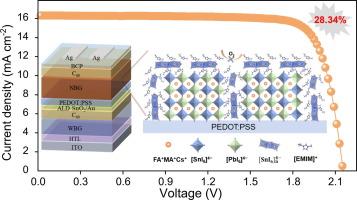通过一维阳离子工程调节锡铅包晶石的结晶和延缓氧化,实现高性能全包晶串联太阳能电池
IF 13.1
1区 化学
Q1 Energy
引用次数: 0
摘要
全过氧化物串联太阳能电池通过减少热化损耗,有望超越单结太阳能电池的理论效率极限。然而,所面临的挑战包括 Sn2+ 氧化成 Sn4+ 以及 Sn-Pb 包晶体中不受控制的结晶动力学,从而导致非辐射重组和成分异质性,降低光伏效率和运行稳定性。在此,我们将离子液体添加剂 1-ethyl-3-methylimidazolium iodide (EMIMI) 引入到锡铅包晶前驱体中,在晶界处形成低维富锡/纯锡包晶石,从而减缓 Sn2+ 氧化为 Sn4+,并调节锡铅基包晶薄膜的成膜动力学。含有 EMIMI 的优化单结 Sn-Pb 类包晶石器件的效率高达 22.87%。此外,结合串联器件中的宽带隙包晶子电池,我们展示了功率转换效率为 28.34% 的双端全包晶串联太阳能电池,并提高了运行稳定性。本文章由计算机程序翻译,如有差异,请以英文原文为准。

Regulating crystallization and retarding oxidation in Sn-Pb perovskite via 1D cation engineering for high performance all-perovskite tandem solar cells
All-perovskite tandem solar cells have the potential to surpass the theoretical efficiency limit of single junction solar cells by reducing thermalization losses. However, the challenges encompass the oxidation of Sn2+ to Sn4+ and uncontrolled crystallization kinetics in Sn-Pb perovskites, leading to nonradiative recombination and compositional heterogeneity to decrease photovoltaic efficiency and operational stability. Herein, we introduced an ionic liquid additive, 1-ethyl-3-methylimidazolium iodide (EMIMI) into Sn-Pb perovskite precursor to form low-dimensional Sn-rich/pure-Sn perovskites at grain boundaries, which mitigates oxidation of Sn2+ to Sn4+ and regulates the film-forming dynamics of Sn/Pb-based perovskite films. The optimized single-junction Sn-Pb perovskite devices incorporating EMIMI achieved a high efficiency of 22.87%. Furthermore, combined with wide-bandgap perovskite sub-cells in tandem device, we demonstrate 2-terminal all-perovskite tandem solar cells with a power conversion efficiency of 28.34%, achieving improved operational stability.
求助全文
通过发布文献求助,成功后即可免费获取论文全文。
去求助
来源期刊

Journal of Energy Chemistry
CHEMISTRY, APPLIED-CHEMISTRY, PHYSICAL
CiteScore
19.10
自引率
8.40%
发文量
3631
审稿时长
15 days
期刊介绍:
The Journal of Energy Chemistry, the official publication of Science Press and the Dalian Institute of Chemical Physics, Chinese Academy of Sciences, serves as a platform for reporting creative research and innovative applications in energy chemistry. It mainly reports on creative researches and innovative applications of chemical conversions of fossil energy, carbon dioxide, electrochemical energy and hydrogen energy, as well as the conversions of biomass and solar energy related with chemical issues to promote academic exchanges in the field of energy chemistry and to accelerate the exploration, research and development of energy science and technologies.
This journal focuses on original research papers covering various topics within energy chemistry worldwide, including:
Optimized utilization of fossil energy
Hydrogen energy
Conversion and storage of electrochemical energy
Capture, storage, and chemical conversion of carbon dioxide
Materials and nanotechnologies for energy conversion and storage
Chemistry in biomass conversion
Chemistry in the utilization of solar energy
 求助内容:
求助内容: 应助结果提醒方式:
应助结果提醒方式:


